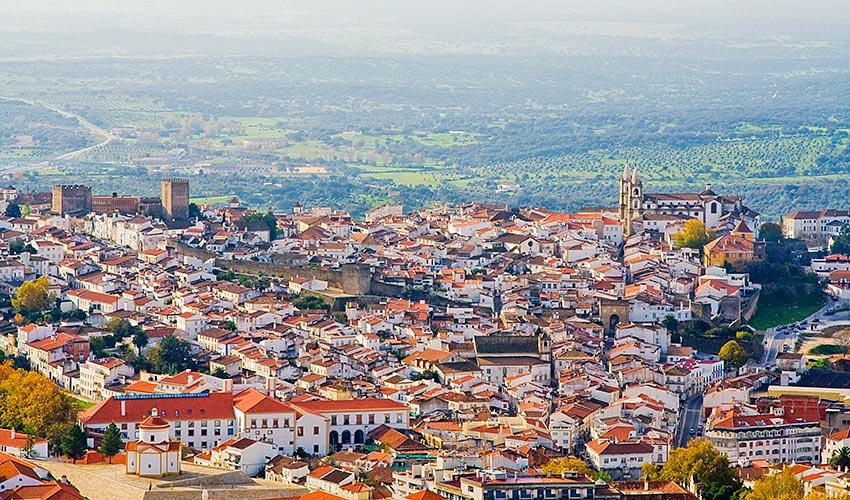Amidst the vast, golden plains of the Alentejo lies the sleepy district of Portalegre, a serene countryside destination brimming with Baroque architecture, colossal medieval castles and intriguing megalithic sites.
Sharing its location with the mesmerising Serra de São Mamede mountain range between Portugal and Spain, this bucolic district stands amongst a unique landscape formed by the rolling fields of the Alto Alentejo sub-region and the dense, luxuriant forests that typify the country’s northern scenery.
As a result of its strategic position near the Spanish frontier, Portalegre served as a crucial point of national defence during the Middle Ages, making it one of Portugal’s most historically acclaimed districts today. Nevertheless, Portalegre is known to have been inhabited long before medieval times and evokes the memory of its earliest heritage with its countless Roman remains and prehistoric monuments.
Visit the capital city of Portalegre and let its winding, cobblestone streets lead you to its most treasured attractions; from Baroque-inspired buildings and charming museums to lovely examples of religious architecture and stunning fragments of medieval walls.
Just a short walk away from the Praça da República, the city’s historic centre, you can admire the ornate wrought iron balconies that adorn the Amarelo Palace, as well as the traditional blue-and-white azulejos that decorate the granite staircase of the elegant Achaioli Palace. Enter the famous São Bernardo Convent and find the delicately sculpted tomb of its founder, appreciate the collection of Mannerist paintings in Portalegre’s beautiful Sé Cathedral and learn about the district’s longstanding textile tradition at the Guy Fino Tapestry Museum. The sacred arts collection exhibited at the popular José Régio House Museum is another suggestion well-worth experiencing during your holiday.
Immerse yourself in the Alentejo’s medieval past and visit the imposing, walled village of Marvão – home to one of Portugal’s most historic castles. On the outskirts of this age-old village lies an impressive excavated Roman site, a fascinating attraction curious travellers will certainly enjoy. The pastoral town of Castelo de Vide is regarded as one of the most romantic areas in the Alentejo and is primarily visited for its Jewish quarter – a captivating part of the district where the country’s oldest synagogue, Gothic-inspired buildings and storytelling streets can all be seen.
The iconic fortress town of Elvas is known for its awe-inspiring aqueduct, grandiose 13th Century castle and selection of museums. Renowned for its delightful cheese and regional handicrafts, the picturesque town of Nisa represents Portalegre’s natural tranquillity and beauty with its splendid hot springs and surrounding dams – some of the most scenic places the Alentejo has to offer.
Places to see
Nature
Parque Natural da Serra de São Mamede (Serra de São Mamede Natural Park)
This unique nature reserve was founded in 1989 and is one of the most interesting examples of biodiversity in the country. With its highest peak reaching 3,500 feet (1,025 metres), this protected park combines the rural scenery of the Alentejo with the lush terrain of Portugal’s northern regions, creating the perfect habitat for a rich variety of flora and fauna. Chestnut trees, oaks, vineyards and olive groves, as well as wild foxes, boar, Bonelli eagles and Europe’s largest colony of bats are some of the surprising examples of wildlife you can find during your visit.
Barragem do Caia (Caia Dam)
Enjoy pure serenity by this peaceful dam and contemplate one of the Alentejo’s most inspiring examples of outdoor beauty. Flowing through the quaint towns of Elvas, Campo Maior and Arronches, the Caia Dam and its artificial lake create the perfect atmosphere for quiet nature walks, water sports and bird watching. Parking facilities and a restaurant are located nearby.
Historical sites
Castelo de Marvão (Marvão Castle)
Commanding spectacular views from one of the highest points of the Serra de São Mamede range, Marvão’s colossal castle is one of the strongest examples of military architecture in the region and a historical symbol of its heroic, medieval past. Despite its numerous alterations during the 15th–17th Centuries, this monumental structure still remains within its austere city walls and possesses its original 13th Century cistern, doorway, keep and gates.
Aqueduto da Amoreira (The Amoreira Aqueduct)
This centuries-old aqueduct is one of the Alentejo’s most popular features and was the project of the famous Portuguese architect, Francisco de Arruda – founder of the iconic Belém Tower in Lisbon. Taking over 100 years to reach perfection, this 24,500 foot-long (7,454 metres) structure still has 843 of its original arches, some reaching over 10 feet (30 metres-high), and continues to provide water to the town of Elvas to this day.
Menir da Meada (The Meada Menhir)
Visit the rural town of Castelo de Vide and see this incredible megalithic monument during your holiday. Commonly regarded as the largest and most well preserved relic in the Iberian Peninsula, this unique, 23 foot-tall (7 metres) granite vestige was discovered in 1965 and is believed to be a Neolithic representation of fertility and life.
Religious architecture
Capela dos Ossos de Campo Maior (Chapel of Bones, Campo Maior)
This intriguing 18th Century chapel is connected to Campo Maior’s main church and was built after an abrupt gunpowder magazine explosion occurred in the town in 1732. Covered with the bones of the 1,500 victims that were killed in this tragic accident, this eerie chapel is the second largest of its kind in the country (after Évora) and will not fail to astonish you with its unusual display.
Sé de Portalegre (Portalegre’s Cathedral)
Built during the late Renaissance period, this elegant cathedral sits at the highest point of the city and is one of Portalegre’s most iconic attractions. Consisting of majestic vaulted arches, three naves, a large dome and a charming, azulejo-adorned cloister, this 16th Century monument is an exquisite example of religious architecture in the district. A beautiful collection of over 90 Mannerist paintings also embellish the cathedral’s interior and are considered one of its prime highlights.

 English
English  Português
Português  Deutsch
Deutsch 



